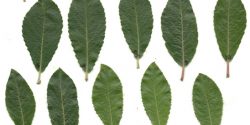Past research
My team began to explore fluctuating asymmetry (FA; small deviations from perfect bilateral symmetry) of plants in the early 1990s, originally in connection with studies of the pollution impact on terrestrial ecosystems. We developed a methodology for assessment of FA in conifers, documented leaf/needle FA of woody plants along multiple pollution gradients, analysed the induction of FA by herbivory, explored the climatic impact on plant FA and discussed the relationships between plant performance and FA. Our plans to use FA for testing the predictions of general ecological theories prompted us to study factors that affect the reproducibility of FA measurements in plant leaves and to explore cause-and-effect relationships between environmental stress and FA.
Ongoing research
I am now exploring the reasons behind inconsistencies and controversies in relationships between FA and environmental stress in plants and insects. In particular, I intend to publish our ‘negative’ and inconclusive results, which have accumulated during two decades of our research, in order to make the publication portfolio more representative of the actual findings. I plan to conduct meta-analysis addressing the impacts of research methodology on conclusions regarding FA responses to environmental stress.
Featured publications
Zverev, V., & Kozlov, M. V. (2020) Decline of Eulia ministrana (Lepidoptera: Tortricidae) in polluted habitats is not accompanied by phenotypic stress responses. Insect Science (doi: 10.1111/1744-7917.12862).
The population density of the brassy tortrix Eulia ministrana decreased 5 to 10 fold from the unpolluted forest to the heavily polluted industrial barren near the copper–nickel smelter in Monchegorsk, northwestern Russia. At the same time, wing length of E. ministrana increased by 10%, and neither forewing melanization nor fluctuating asymmetry change in the same pollution gradient. Thus, none of the studied potential morphological stress indicators signaled vulnerability of E. ministrana to environmental pollution and/or to pollution‐induced environmental disturbance. We conclude that insect populations can decline without any visible signs of stress.
Kozlov, M. V. & Zverev, V. (2018) Temperature and herbivory, but not pollution, affect fluctuating asymmetry of mountain birch leaves: results of 25-year monitoring around the copper-nickel smelter in Monchegorsk, northwestern Russia. The Science of the Total Environment, 640–641, 678–687 (doi: 10.1016/j.scitotenv.2018.05.328).
We monitored the leaf fluctuating asymmetry (FA) of mountain birch, Betula pubescens subsp. czerepanovii, from 1993 to 2017 in individually marked trees at 21 sites around the copper‑nickel smelter at Monchegorsk. We found that FA did not correlate with pollution load, but it decreased considerably with an increase in June air temperature and it increased slightly but significantly with an increase in the previous-year leaf damage by insects. Our findings suggest that climate warming is unlikely to impose stress on the explored mountain birch populations, but even small increases in insect herbivory may adversely affect birch trees.
Zverev, V., Lama, A. D. & Kozlov, M. V. (2018) Fluctuating asymmetry of birch leaves did not increase with pollution and drought stress in a controlled experiment. Ecological Indicators, 84, 283‒289 (doi: 10.1016/j.ecolind.2017.08.058).
We experimentally demonstrated that drought and heavy metals had no effect on leaf fluctuating asymmetry in mountain birch, Betula pubescens subsp. czerepanovii, despite significant impacts of these treatments on seedling height, leaf size and photosynthetic efficiency.
Kozlov, M. V. (2017) Plant studies on fluctuating asymmetry in Russia: mythology and methodology. Russian Journal of Ecology, 48, 1‒9 (doi: 10.1134/S1067413617010106).
A critical analysis of studies addressing fluctuating asymmetry (FA) of plant leaves, published recently in Russia, demonstrated that most of these studies are based on insufficiently substantiated assumptions, employ outdated or inadequate methodology and do not contain sufficient information to support the use of the reported results in further reviews and meta-analyses. Contrary to widespread opinion, the current level of knowledge does not allow practical use of FA for bioindication. An adequate assessment of FA requires repeated, high precision measurements, which should be conducted blindly.
Kozlov, M. V. & Zvereva, E. L. (2015) Confirmation bias in studies of fluctuating asymmetry. Ecological Indicators, 57, 293-297 (doi: 10.1016/j.ecoind.2015.05.014).
We experimentally tested the hypothesis that the outcomes of studies addressing fluctuating asymmetry may be influenced by confirmation bias, i.e. the tendency of humans to seek out evidence in a manner that confirms their hypotheses and beliefs. We asked each of 31 scientists to measure FA from the scanned images of the same set of birch leaves and provided these scientists with either true or false information about the origin of these leaves. The participants who believed that the leaves originated from a heavily polluted site reported significantly higher values of FA when compared to the participants who believed that the leaves were collected from an unpolluted site. We conclude that when scientists expected to find high FA in some samples, the results of their measurements confirmed their expectations.
Kozlov, M. V. (2015) How reproducible are the measurements of leaf fluctuating asymmetry? PeerJ, 3, e1027 (doi: 10.7717/peerj.1027).
The reproducibility of fluctuating asymmetry (FA) was explored by comparing the results of measurements of scanned images of 100 leaves of downy birch conducted by 31 volunteer scientists experienced in studying plant FA. The overall reproducibility of the results among the participants was rather low (0.074). The scientists working with plant FA are advised to pay utmost attention to adequate and detailed description of their data acquisition protocols in their forthcoming publications.
Valkama, J. & Kozlov, M. V. (2001) Impact of climatic factors on the developmental stability of mountain birch growing in a contaminated area. Journal of Applied Ecology, 38, 665-673 (doi: 10.1046/j.1365-2664.2001.00628.x).
We examined fluctuating asymmetry (FA) of mountain birch leaves along a strong pollution gradient in the Kola Peninsula, north-western Russia, from 1993–2000. FA did not increase near the smelter, presumably because only pollution-resistant genets survived in heavily polluted sites. There was, however, variation in FA between years: highest values of developmental instability were recorded during the coldest summers, and birch genets differently responded to climatic fluctuations. Our results demonstrate that FA may serve as a useful measure of climatic stress in plants.
Co-authors
T. Cornelissen
D. E. Gavrikov
E. Haukioja
J. Junttila
J. Koricheva
M. A. Kunavin
A. D. Lama
†E. Mälkönen
J. R. Milligan
P. Niemelä
J. Valkama
B. Wilsey
Co-operating scientists
R. Ambo-Rappe
I. B. Amosova
Yu. V. Belyaeva
P. Cuevas-Reyes
F.V. Costa
O. V. Ereschenko
I. Yu. Glinyanova
E. E. Ibragimova
M. Kaligaric
B. Komac
I. S. Korotchenko
O. V. Lozinskaya
S. I. Marchenko
P. Nuche Gálvez
M. G. Opekunova
O. A. Pospelova
A. V. Rodikova
M. N. Rossi
J. C. Santos
A. S. Sarsatskaya
T. Kh. Shadmanova
E. G. Shadrina
Z. A. Simonova
E. A. Skochilova
N. A. Smirnova
V. Yu. Soldatova
O. A. Timokhina
T. Wuytack
H. Yousefzadeh
Funding
Academy of Finland
Maj and Tor Nessling Foundation

